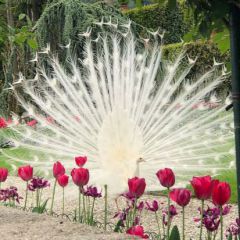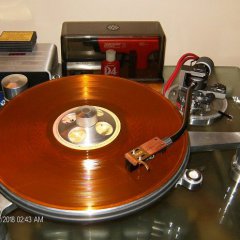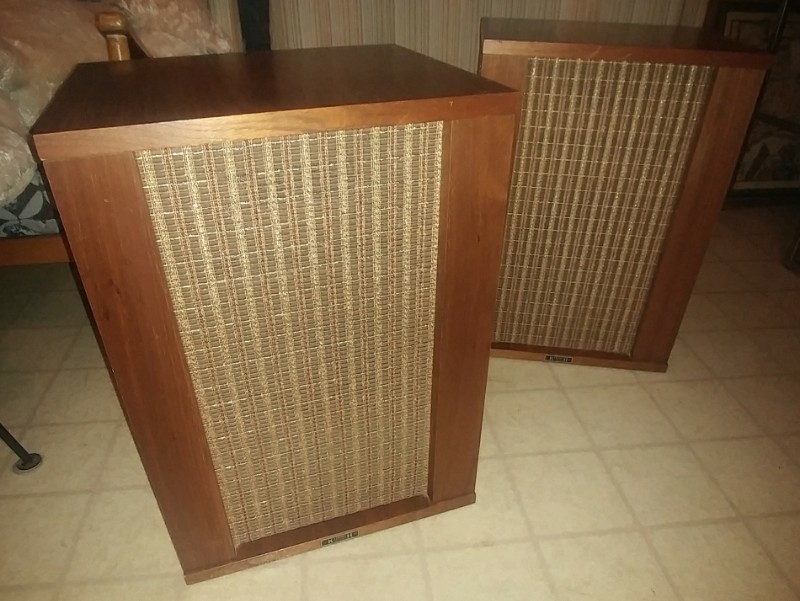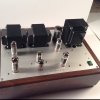Search the Community
Showing results for tags 'crossover'.
-
Hi there I have a Marantz SR-7010 receiver and I added the following speakers: Floor standing Klipsch RP-280f Center Klipsch Rp-450c Subwoofer Klipsch R-112SW I run the marantz audyssey setup and then went manually to touch the central speaker and raise it up 5db more. Im quite happy with the movie dialogs they sound crystal clear but I need to still tweak the subwoofer a little more. I want a more tight punch. My speakers are set to small and the crossovers are: Rp-280f says fullband central 40hz and then in the sub config its LFE 120hz (at the back of the sub I have the auto OFF, phase to 0 and gain around 3/4db. that according to audyssey its 75db) Any hint in how to configure correclty this set up for a tighter punch. Room size is 20 square meters approx. If you need any other detail let me know, thanks a lot
-
-
New to me set of Belle. Sold my Lascala last year, and been sorry I did so. Saw a set of Belle on local Craig's and jumped. Matching veneer, type AA xover...question: It looks strange... square caps, 2 sets of protection instead of the 1 I'm used to seeing. Anyone know if these are stock? Nothing like them online that I can see. Paperwork with these is dated 1971. Serial 306 and 307. Also, when I had the lascala, I bought xovers from Alk, and mid lense fastrac lascala from Fastlane. Is it ok to run the xovers and lense in these Belle? Providing I can fit it in there.. Any opinions appriciated.
-
3-Way crossover/balancing network for Klipsch LaScala, Belle Klipsch or Klipschorn. Can be configured for either 4500 or 6000 hz crossover to the tweeter. NOTE: USE OF STANDARD K-77 TWEETERS CROSSED OVER at 4500 hz IS NOT RECOMMENDED. DAMAGE TO THE TWEETER MAY OCCUR. Very good condition. Very limited use. $179. Price includes shipping. Shipping within Continental US only. Also available for local pickup in the Washington, DC Metro area. Cash only. https://critesspeakers.com/crossovers.html https://critesspeakers.com/bk-sound-type-a4500-crossov.html 1) 400/4500 Each of the Red and Black wires marked “1,2,3 and 4” are connected via the Male and Female quick connect ends 2) 400/6000 Disconnect the Red and Black wires marked “1,2,3 and 4”. Connect 3 Red and 4 Red.
-
Hey Everyone, I had such a great response from the forum last time I posted here that I decided instead of again suffering too much trying to figure out the answer myself I would again ask here (see below for my previous post). There is such a vast wealth of knowledge and experience here that I would be foolish to not ask for your insight and ideas. I want to do a refresh on my Klipsch Heresy I speakers crossovers, they haven't been touched since they were produced in 1977. I have decided that I want to do the following: - replace the Capacitors (100%) - replace the wire (maybe not but I kinda do) - understand what those strange things are look like metal frames holding a wound up paper with wires going into it (there are two of them, and they are the only other thing than the capacitors in the crossover, can these fail? should they be replaced?) - any success with replacing the terminals on the back of the speakers? Is this necessary? I feel like to be sure it would be good to replace them, but I hate the idea of changing the speakers too much, especially externally. So from what I understand is that many consider the Sonicaps too bright and therefore I have leaned towards two options: - Mundorf Silver in Oil - Jensen NOS Paper in Oil (if I can secure them) So the questions that I have currently are: - Have you tried the Mundorf or the Jensen? What caps have you had success with? - I need a parts list with specific measurements required and I can't decipher a electronic schematic, thank god I have a good and honest tech here locally so I can get the work done, soldering, ect. - any suggestions for wire that I should use internally for these speakers? I understand that it is better to have a bit of a smaller gauge especially when using a tube amplifier and highly efficient speakers. Should I keep the original? These speakers are in surprisingly good condition for their age... I'll ping the stand up guys that helped me the first time. Thanks guys! @JohnA @jimjimbo @CECAA850 @MC39693
-
I'm looking to revamp my modified K-Horns with new crossovers, and was wondering if anyone has tried Al's economy crossover? It looks like everything I need (squawker and tweeter attenuation). Just wondering if it would be appropriate to use with the non stock drivers in my system? I am currently running Crites cast woofers, Selenium D405 mid and Selenium T220 tweeters on custom made tractrix wood horns. My current crossovers are universal type 400/4500 crossovers. I want to go back to 400/6000 crossover points because I'm changing my listening room to a smaller footprint and will be more of a close range listening environment. Any input would be greatly appreciated.
-
I just purchased the speakers mentioned in the title for a home theater setup. I will be using it mainly for movies/games and have a pioneer elite VSX-LX302 receiver. i ran through the MCACC calibration and it set my front R-26F to large and others to small with 100Hz crossover. It seems a little heavy on the bass with this setting and thought I would change the R-26F to small but I can only set one crossover setting for all speakers. If I keep it at 100Hz, is it even worth having the floor standing R-26F speakers? Or would I have been better suited with bookshelf speakers? Any help with crossover or bass knob settings would be greatly appreciated! R-26F = 38Hz - 24kHz R-25C = 82Hz - 24kHz R-14S = 83Hz - 24kHz R-12SW = 29Hz - 120Hz
-
I recently hit the jackpot on craigslist and scored a complete system for just $299. The insane part is when you hear what the main speakers are. Mains: RF-7 Center: RC-3 Sub: KSW-12 Surrounds: RS-3. Receiver: Yamaha RX-V2400 EVERYTHING TOGETHER for only $299!!!!! And they're in good shape. He just wanted them out of there. Or his wife did. I already sold the sub and the receiver so I'm almost down to $0 for the RF-7s!!!!!!!!!!! Now, to see if I can upgrade the crossovers on the RF-7's. I tried to call Dean using the number and email listed on his facebook page but the number didn't work so I shot him an email and message but haven't heard back yet. Is he still doing crossovers? Or are there details and instructions somewhere so I can buy the parts and do it myself? Thanks!
-
Hello Klipsch audio community, this is my first post here - actually I made an account specifically to ask about this topic, which has been mystifying me. I pick up multimedia speakers at my local thrift stores quite frequently, and Klipsch ProMedia speakers are a common sight (people seem to get rid of them because the pots on the control pods go bad). Usually I end up with a large number of ProMedia satellites with an odd mixture of subs and control pods, so I mix and match until I end up with complete systems, which isn't very difficult. I quickly noticed, however, that there seem to be a noticeable difference in tonality between some of the satellites - and the differences are often split between satellites from entire sets (for example, the 4 satellites I picked up from a ProMedia 4.1 set sounds noticeably brighter and louder than the satellites I found from an old ProMedia 2.1 set from the early 2000's). I know that companies often do iterative updates to their products' internal components, and I wanted a way to be able to identify the different satellite revision(s) so I can match them properly when I put together systems. After finding absolutely no cosmetic differences in the satellites' exterior, I decided to open them up... and what I discovered was a bit, well, surprising. In the photo attached below, you can see two satellites right next to each other. They look identical on the outside. Opening the first satellite, one can see a circuit board to handle the crossover. It appears to contain a capacitor, a resistor, and an inductor, pretty standard affairs for a crossover circuitry. Opening the second satellite, one finds that the entire circuit board to be missing. In its place is a single bipolar capacitor, manufactured by Bennic. My guess is that the first satellite is in fact the older version, because the circuit board is screwed onto two plastic mounts that, in the second satellite, are still present but unused. When I first started researching the topic, I came across an old discussion about the ProMedia 4.1, which was stated to have "improved crossover frequencies". Coincidentally, the first time I noticed the tonal differences in the satellites, it were ones from a ProMedia 4.1 system (containing the second version, with the single capacitor). I currently have 18 ProMedia satellite speakers on hand. I have opened up every single one, and found that 12 of them were of the second iteration, while only 6 were of the original configuration. So the "new" version has been around for a long while. I am not an electrical engineer, but a quick read on how crossover circuits work showed that inductors act as low pass filters (becoming more reactive as frequency increases), while capacitors act as high pass filters. The fact that the inductor and its companion resistor are absent in the "new" revision of the satellites likely means that the full-range driver is receiving the full spectrum of audio signal (minus whatever LFE that's sent to the subwoofer by the filter in the amp module), including everything that's meant for the tweeter. This may explain why these satellites sound somewhat brighter (I am assuming the full-range driver can reproduce at least some of the treble frequencies), as well as louder (less components in the signal path, less resistance). Now.. I know audio companies spend a lot of money on R&D, so I am not accusing Klipsch of cutting corners or anything like that. My main question is... which satellite version actually perform objectively better? I do not have any instruments to measure frequency responses, but may be someone can look into this? And a question for Klipsch: What is the reason behind this internal change? Do the new satellites still perform up to THX specifications?
-
My Audyssey microphone was DOA and I've been patiently awaiting it's replacement. I figure I can go the manual route for now. My setup is as follows and I was hoping you guys could help me with some of the finer details in terms of the crossovers, large/ small, +-db settings etc.., just to get a guy started. -Denon 4300H Receiver -Klipsch R-26 towers (x2) for my L & R (and currently setup as center) -Future state-Klipsch R-15M bookshelf (single) for center once we get our console table in place under the TV . Side Note- would it be blasphemous to have it on its side laying down to save on height? -Bose 161 (x2) for surrounds (hung on basement soffit ~6.5ft from floor nearly directly to the left/right of seating position) -Monoprice Caliber Series 8" ceiling speakers (x2) -Klipsch R-10SW Subwoofer (10") (x1) The main seating position is about 12ft from the towers and the sub, 7ft from the surrounds and 7ft from the heights. 12AWG connecting it all in wall. I’m setting this up as a 5.1.2 Atmos setup for movies and some gaming. Any advice is welcome. I’m a pretty technical individual, but not so much in the audio realm. So I can follow instructions, but coming up with the finer points myself will be a learning process. Thanks folks!
- 4 replies
-
- help
- home theater
-
(and 3 more)
Tagged with:
-
Hi All. This thread relates to whether or not a rule of thumb can be established for safely lowering crossover frequencies by increasing crossover slope and/or reducing the wattage specification of HF compression drivers. I am currently stuck in a never ending search for a reasonably priced 1" throat compression driver that can be crossed over at 500 HZ, in a two way speaker system. I have another thread in these forums that has progressed to the point where I have a few general questions about HF compression drivers and their crossover specifications. I think that answers to these questions would be beneficial to anyone who finds themselves in a similar situation as myself. The following are my questions: 1. If a compression driver is specified as having a cross over at, for example, 1000 HZ @ 12 DB/octave @ 100 Watts, what would be an acceptable crossover frequency at 24 DB/octave? 2. If this same compression driver is operated at, for example, 50 Watts maximum, would a 500 HZ @ 12 DB/octave be okay to protect the driver from damage? If not, what might be a more acceptable safe wattage at this particular crossover frequency and slope? 3. If, like myself, you use DIY SET tube amps of between 2 and 8 watts, and have no intention of ever exceeding 25 Watts (I have a DIY Aleph J in the works), what does the specification of 1000 HZ @ 12 DB @ 100 Watts mean to my choice of a 500 HZ crossover point at 2 Watts maximum, 8 Watts maximum, and 25 Watts maximum? I am not sure what percentage of the wattage available in my amps will actually go to the HF compression drivers, but I would imagine that most would go to the bass bin. There are some manufacturer's spec sheets that give a clue to what the answers might be, as is the case in the following two Radian spec sheets, but it seems that Radian is the exception when it comes to showing this specification. Also, there is not a consistent change with respect to the rate of change in the crossover specifications for these two drivers. For example, the specification sheet for the Radian 651PB/760PB/850PB shows 1200 HZ @ 12 DB and 500 HZ @ 24 DB at 50/60/75 Watts respectively, while the 450PB/465PB/475PB sheet shows 1200 HZ @ 12 DB and 800 HZ @ 24 DB at 25/35/35 Watts respectively. http://www.usspeaker.com/radian 760pb-1.htm https://www.parts-express.com/pedocs/specs/manufacturer-specifications-44920.pdf At the moment I am at the beginning of putting together a two way speaker system with Peavey FH-1 as bass bins (they were delivered earlier today), and Altec 511B as a HF horn with Renkus-Heinz SSD 1800-16 compression drivers. I have a Behringer CX3400 on loan that has 24 DB/octave slopes, but I may go passive or choose a different active crossover when I get my own. I also have Altec 811B horns, which I would like to combine with a DIY bass cab to create a two way. I would also like to acquire either a Klipsch K510 or K401 in the future, and I will need 2" throat compression drivers for these horns, which will be used with either the bass bin portion of my La Scalas, the FH-1s, or the bin I build for the Altec 811Bs. Having the above questions answered could, depending on the answers, greatly expand the choices of compression drivers that would be appropriate for these builds. Thank you in advance for any information/answers that you can provide to these questions. Tiz
- 19 replies
-
- low wattage
- frequency
-
(and 2 more)
Tagged with:
-
I am trying to figure out which crossover settings to use on my Onkyo TX NR-646 receiver. My Fronts are RP-250F, RP-440C center, RP-240S rear surround, Yamaha YST-SW216 10" 100 watt sub and Onkyo SKH-410 Atmos Speakers. And what are the best settings n this receiver for watching mainly action movies? Thanks
-
This is a newbie question. How does one remove the crossover from the cabinet? I don't see any screws or the like. Does the mid range horn need to come out too? Thanks in advance.
-
I recently purchased RP-280F towers and a free R-112SW came with them. What is the optimal crossover for pairing them with the sub? I currently have them at 80Hz
-
A set of AlK engineering Crossover set. two ea. AP12-600, and two ea. ES 5800 extreme slope. AP12-600 This one is intended for the Belle Klipsch or the La Scala using squawker drivers or horns that will not safely go down to 500 Hz. The crossover is at 600 Hz. This the preferred crossover for The Klipsch Cornwall, Cornwall II, and Corn Scala , Corn Altec etc. These have the midrange level adjustable Autoformer 1 db steps. These are $350 new plus fedex shipping . ES 5800 The 5800 Hz crossover is the recommended frequency for most applications. All versions uses ClarityCaps in the signal path to the tweeter EXCEPT the ES7500. Solen astCaps are used as ClarityCaps are not available in the required value for that crossover frequency. All have adjustable tweeter level settings of 0, -3, -5, -7 and -9 dB attenuation. Auto former . The bi-amp version allows mid-range setting from 3 to 18 dB in 1 dB steps. These are $ 420 new plus fedex I will sell both sets together $700 fedex included to Continental/Contiguous USA call, text or email 5one2 590 9234 billzumwalt@hotmail.com
-
My KLF20s have a 1.25 uF cap. Nobody seems to have this value. Crites claims to use Sonicaps in his upgrades kits but Sonicap website doesn't list this value. Paralelling 2 caps to get close to 1.25 seems to be expesinsive. Do you replace with 1.2 or 1.3 uF? There is also a 8mF electrolitic in the woofer circuit.. again hard to find in a "audio grade" cap. Replace with 8.2? thanks guys and gals
-
Hey Klipsch community! In the past couple years I've been bitten by the audiophile bug and I've been driven to find new and better ways to enjoy movies and especially music. First I got the two RP-160m bookshelf speakers, then the RP-250C center channel, and this week I finally got my sub, the RP-110SW. I've been happy with the bookshelf and center channels, but I'm pretty sure I have no idea what I'm doing on setting up the appropriate crossover--for the 160's and especially the sub. I'm wondering what the best crossover setting for the receiver would be, and also on the sub itself. I've read a bit and trying out different things, but thought I'd ask in case someone has a similar setup or could show me the way. I'm not sure if it matters, but I'm using an Onkyo TX-NR555 receiver. Thanks for any assistance you can offer!
-
Hello everyone, I bought a couple of Klipsch Heresy I 1972 (Tweeter: K77 Midhorn: K700 plus K55V driver, woofer: K22E alnico NOT RED SURROUND OF H700 Model) They have Type C crossovers but the woofers impedance is 8 ohm. Do I have to change the crossovers on type D or E configuration?
-
Got this X-over as part of a bigger parts purchase, don't know which Klipsch model it was designed for or if it works. Have no idea what it is worth, taking offers. Thanks!
-
f3 crossover Synergy F3's with damaged crossovers
NightHawkATL posted a topic in Technical/Restorations
Hello all, This is my first post in the forum and I have done a few searches and have called or emailed Klipsch and they sent me to a place that no longer existed. I purchased a pair of Synergy F3's for a great price knowing that there was an issue when I tested them before buying. I was unable to hear anything from the tweeters so I pulled the tweeters and they looked fine. I pulled the terminal plate out to get to the crossover and found that they were fried. I am trying to locate some original F3 crossovers to bring my new purchase back to spec for the best listening experience. One thing that I can tell you right now, if you bypass the crossover for the tweeters, you will get some impressive highs from them! Ear-piercing to say the least but the tweeter response is phenomenal! If I can't source the whole board, I guess I can get a friend of mine (Masters in Electronics Engineering) to replace the faulty parts ore even just rebuild it all on the original board. Last option would be to bypass the whole thing and do an external crossover, but I am not really sure how well that would work. -
II have recently acquired a pair of consecutively numbered (164 & 165) Klipsch Model H speakers. I have found some information on them, but had more questions. It seems there were 18 of the 8" versions of these, but how many where made of the 12" in this style? Is there more information about various drivers in these? Based on looking at the screws before opening, they don't seem to have been opened before I took the back off of one, but the 12" driver is a Cletron Cathedral. The nuts holding the speakers all have the same amount of white corrosion too. Did this brand of woofer show up in other early Klipsch speakers? Lastly, I will need to change the capacitors. One has a 2uf with two taps and wires going to each of those. The other is 4uf with one tap where two wire attach, and another wire going to the metal can of the capacitor. I'm curious how to wire modern caps in place of these, I have an idea, but would like to hear other thoughts to be sure. Mostly I wanted to share photos since there aren't many of this model that I can find, and I didn't see any photos of the inside. These are extremely clean all around, excellent condition of wood and cloth.
- 9 replies
-
- 3
-

-
- klipsch model h
- crossover
-
(and 1 more)
Tagged with:
-
Selling my matched ALK ESN 500hz and ESN5800hz crossovers. With these you have perhaps the finest crossovers made. Run as 2way or 3way. Al has a switch you can add to make the switch on the fly. Currently $1340 for the pair plus shipping. Asking $1000. Approx 11mo old. Headed toward some Jubs so they get to find a new home. These are separately boxed. Not keen on separating but may consider. Justin 323-868-9722
-
New member the forum, but I've been reading here for years. I recently had a pair of La Scalas that came with an extra pair of crossovers. I passed the La Scalas on, but I still have the extra crossovers. I want to build a pair of Cornwalls. The crossovers look just like Cornwall crossovers, but there must be some differences. If you were to put together a set of Cornwalls from mix-n-matched components, which horns, mids, & drivers would you use? Or would you just build cornscalas instead?
-
Just bought a pair of LSi which have AL X-O. Just got my MC30s today and am loving the sound but based on the age of the speakers, I was thinking of rebuilding the X-O with new caps. I read the AL is not the best and people prefer the AA or AL-3. I read it isn't cost effective to convert an AL to an AA. Is it possible (cost effective) to update the AL to AL-3 during the rebuild or do I need to buy a new AL-3 X-O? Carmen
-
Hello, I would like to ask you for 2 questions... 1) how huge should be room for r115 sw? I got r110sw in 6x4 meters. Its really bone rattling booms shaking with my internal organs i got it only on 40%. I got lpf and in rcv 80-100hz. In tron movie about 42minutes its hardcored so i am afraid of r115. My friend has a r110 and smaller room and he cant reach my sound on 70%. I think its cause by room acustic. So should i go for r115? 2) how is your setups, is there any recommended setup? I got floorstands rf82 ii which is playing from 32hz i guess and i set it in RCV from 50hz, center 450c is from 60hz and surrounds rb61ii are from 50hz. Lpf is 80 sometimes 100. My setup is : front: rf 82 ii Center: 450c Surrounds: rb 61 ii Subwoofer: r110 sw Thanks a lot for advise.
































